外研版英语七年级上册Module 6 Unit 1 Does it eat meat 课件(共43张PPT)
文档属性
| 名称 | 外研版英语七年级上册Module 6 Unit 1 Does it eat meat 课件(共43张PPT) | 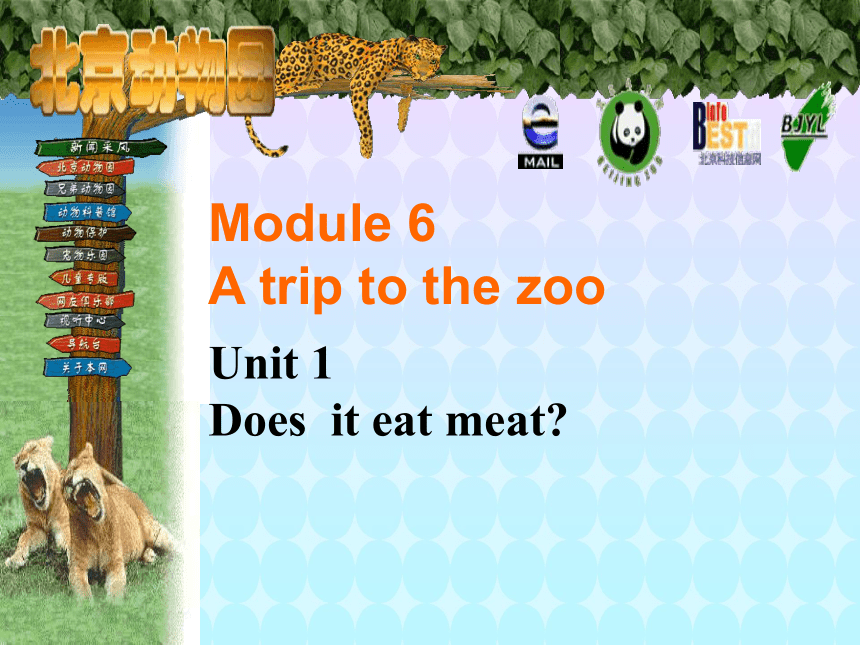 | |
| 格式 | zip | ||
| 文件大小 | 3.3MB | ||
| 资源类型 | 教案 | ||
| 版本资源 | 外研版 | ||
| 科目 | 英语 | ||
| 更新时间 | 2020-09-17 18:16:50 | ||
图片预览

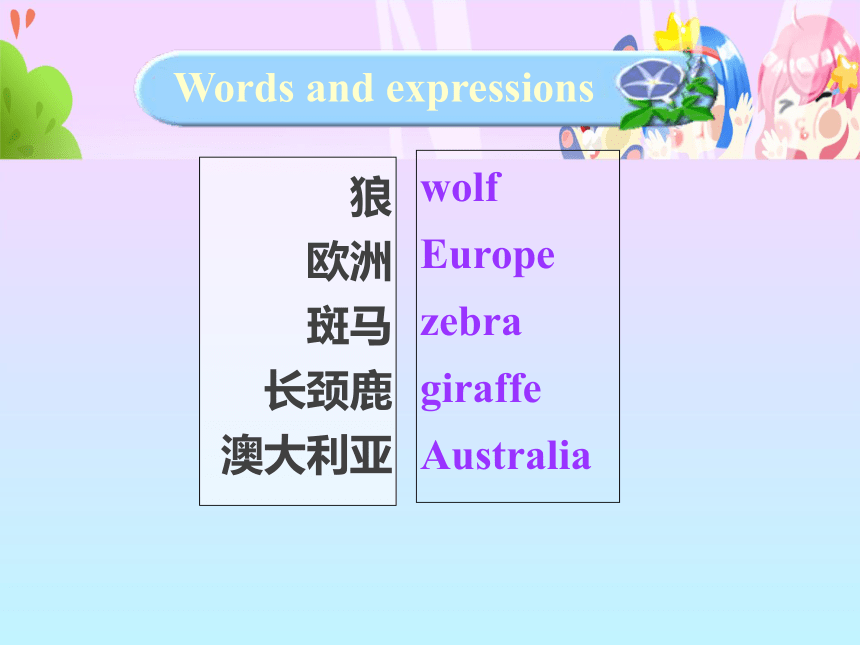
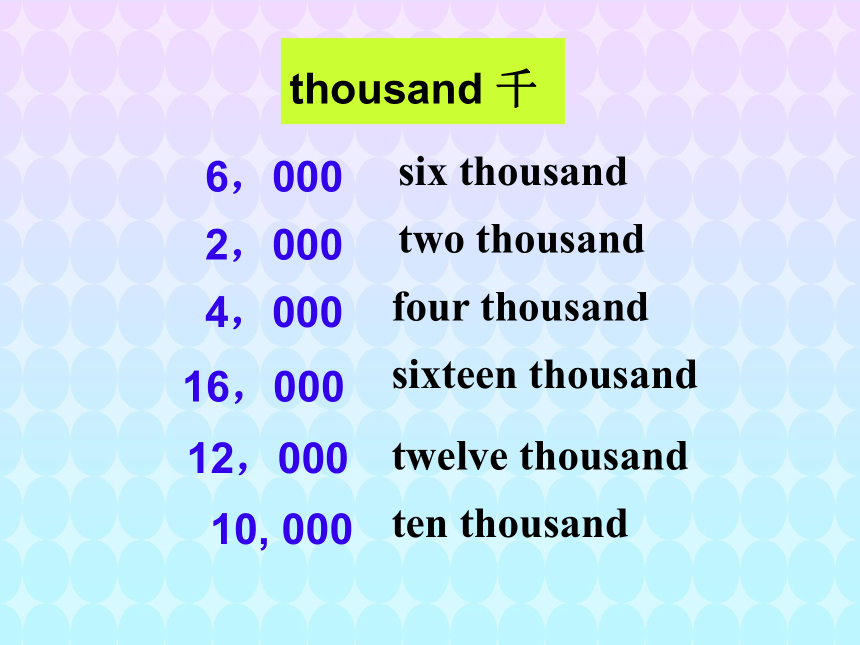
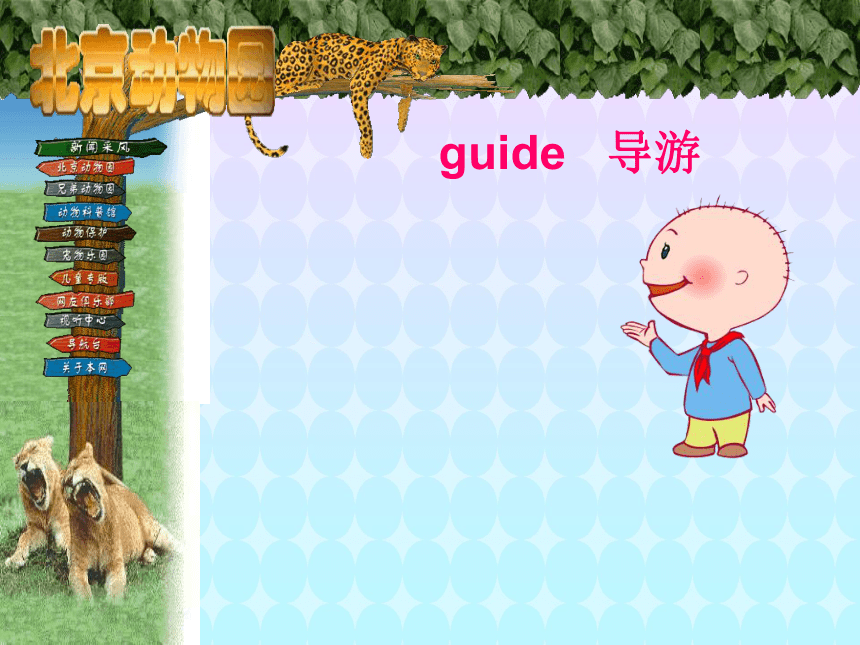
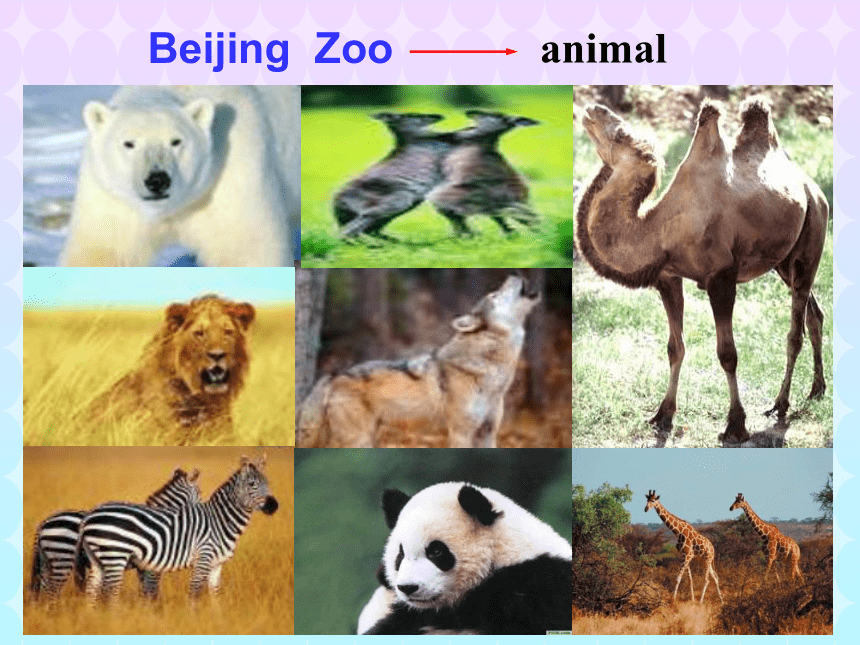

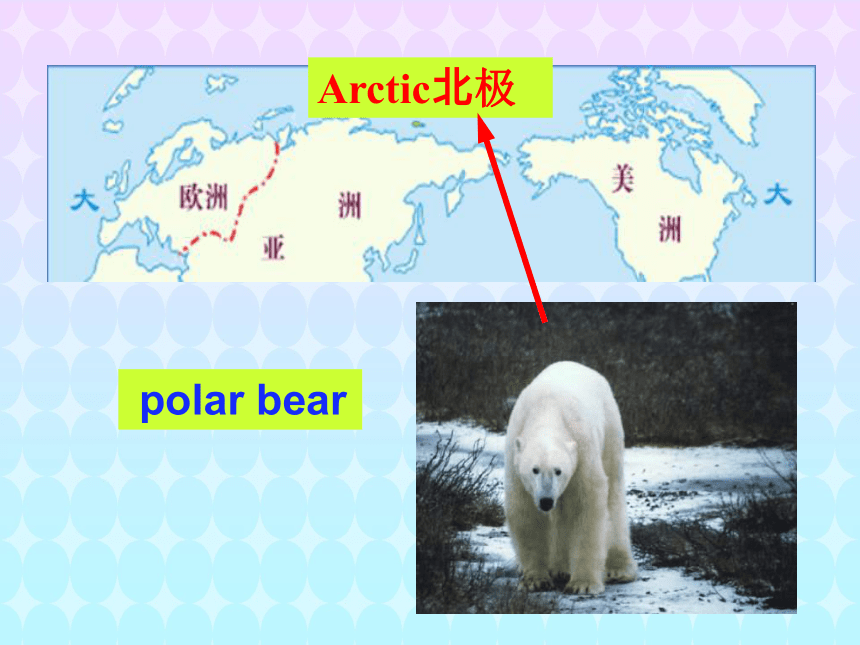
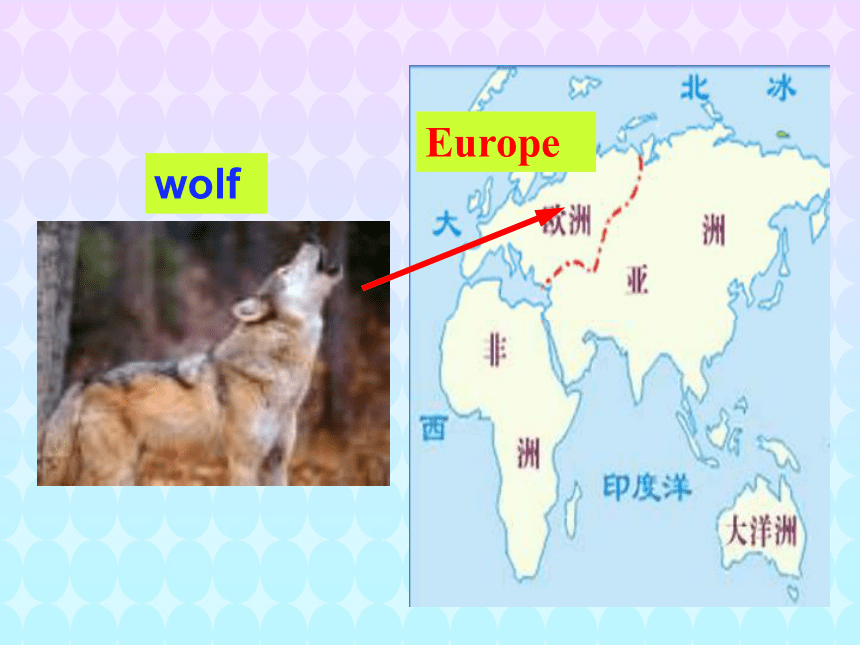
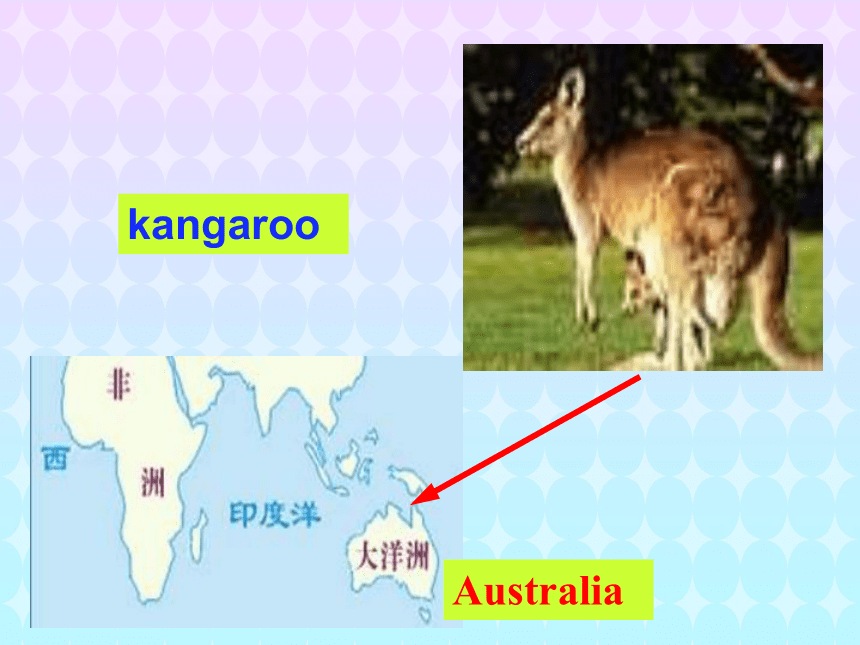

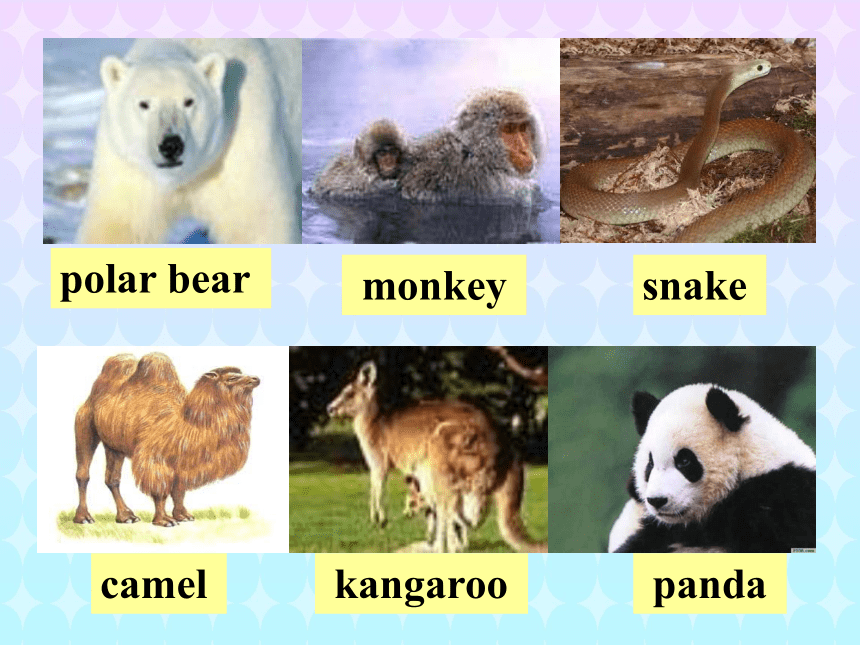

文档简介
(共43张PPT)
Unit
1
Does
it
eat
meat?
Module
6
A
trip
to
the
zoo
wolf
Europe
zebra
giraffe
Australia
狼
欧洲
斑马
长颈鹿
澳大利亚
Words
and
expressions
thousand
千
six
thousand
two
thousand
four
thousand
sixteen
thousand
twelve
thousand
6,000
4,000
2,000
16,000
12,000
10,
000
ten
thousand
guide
导游
Beijing
Zoo
animal
camel
Asia
Does
the
camel
come
from
Asia?
Yes,
it
does.
No,
it
doesn’t.
Does
the
camel
eat
meat?
Arctic北极
polar
bear
wolf
Europe
kangaroo
Australia
elephant
giraffe
lion
tiger
wolf
zebra
camel
kangaroo
monkey
panda
polar
bear
snake
zebra
monkey
snake
giraffe
elephant
lion
tiger
panda
polar
bear
kangaroo
Listen
and
say
what
animals
you
can
see.
(Activity2)
Write
questions
and
short
answers.
Panda
/
eat
/
bamboo
?
(
)
Does
the
panda
eat
bamboo?
Yes,
it
does.
+
1.
camel
/live
/desert
?(
)
2.
kangaroo
/
eat
/
meat
?
(
)
+
-
Does
the
camel
live
in
the
desert?
Yes,
it
does.
Does
the
kangaroo
eat
meat?
No,
it
doesn’t.
3.
elephant
/
work
/
forest
?
(
)
4.
snake
/
like
/
water
?
(
)
+
-
Does
the
elephant
work
in
the
forest?
Yes,
it
does.
Does
the
snake
like
water?
No,
it
doesn’t.
Check
the
true
sentences.
(Activity
4)
1.
There
are
7,000
animals
in
the
zoo.
(
)
2.
The
kangaroo
lives
in
Europe.
(
)
3.
The
polar
bear
lives
in
the
Arctic
.
(
)
4.
The
polar
bear
comes
from
China.
(
)
5.
The
tiger
eats
meat
.
(
)
6.
The
tiger
comes
from
Asia
.
(
)
7.
The
panda
comes
from
China.
(
)
8.
The
panda
doesn’t
eat
bamboo.
(
)
×
√
×
×
×
√
√
√
5,000
Australia
the
Arctic
eats
Listen
and
repeat
the
questions
and
answers.
(Activity
6)
-Does
the
panda
eat
bamboo?
-Yes,
it
does.
It
eats
bamboo.
-Does
the
tiger
come
from
Europe?
-No,
it
doesn’t.
It
comes
from
Asia.
Work
in
pairs.
Ask
and
answer
the
questions.
(Activity7)
1.
Does
the
tiger
eat
meat?
2.
Does
the
panda
eat
bamboo?
Does
the
polar
bear
like
to
swim?
Yes,
it
does.
It
likes
to
swim.
Yes,
it
does.
It
eats
meat.
Yes,
it
does.
It
eats
bamboo.
3.
Does
the
tiger
like
to
swim?
4.
Does
the
polar
bear
eat
bamboo?
5.
Does
the
polar
bear
come
from
China?
No,
it
doesn’t.
It
doesn’t
like
to
swim.
No,
it
doesn’t.
It
doesn’t
eat
bamboo.
No,
it
doesn’t.
It
doesn’t
come
from
China.
1.
Sixteen
thousand
people
visit
it
every
day.
它每天接待一万六千名游客。
1)
thousand
是数词“千”。
表示“几千”时,通常用“数词+thousand
+名词复数”表示“数千”时,通常用
“thousands
of
+名词复数”
三千人 three
thousand
people
数千人 thousands
of
people
2)
①
visit
在此处是及物动词,“游览,参
观”
的意思,后接地方。
②
visit
还有“拜访,看望”之意,后接人。
I
often
visit
my
grandfather.
我常常去看望爷爷。
③
visit
还可作名词用,有“参观,访问”之
意,其后常跟介词to,说明去何地访问。
on
a
visit
to
Japan
访问日本
3)
every
在这儿作形容词用,其后接单数可数名词。
Every
student
comes
here.
每个学生都到这儿来了。
2.
The
zoo
has
five
thousand
animals-
kangaroos,
polar
bears,
zebras,
pandas
and
many
more.
动物园有五千只动物-袋鼠,北极熊,斑马,熊猫,还有很多别的动物。
1)
The
zoo
has
five
thousand
animals.
可用there
be
句型来表达。
There
are
five
thousand
animals
in
the
zoo.
2)
more
在句中作形容词,“另外的;
又,再”的意思.这时more
往往用在数
词或表示数量的词,如:some,
many,
several等的后面。
eg:
Would
you
like
some
more
rice?
你还要吃些米饭吗?
3.
Look,
there
she
is.
看,她在那儿。
这是一个倒装句。句子中如果出现副词
here,
there位于句首,常用倒装句式。
如果主语是名词,则用全倒装“Here
+系动词+名词”;如果主语是代词,则
用半倒装“Here
+代词+系动词”。
eg:
Here
is
his
father.
他父亲在这儿。
Here
you
are.
给你。
4.
The
kangaroo
lives
in
Europe.
袋鼠生活在欧洲。
表示“一类”①
the
+名词复数
②
a
+
名词单数
③
名词复数
eg:
熊猫吃竹子。
①
The
panda
eats
bamboo.
②
A
panda
eats
bamboo.
③
Pandas
eat
bamboo.
一.
根据所给汉语完成单词。
1.
There
are
three
________
(千)students
in
this
school.
2.
The
lion
_____
(来自)America
is
very
strong.
3.
The
___
(旅行)to
Hong
Kong
is
very
interesting.
4.
The
______
(狼)are
very
dangerous.
5.
We
need
a
_____
(导游)to
help
you.
6.
The
trees
in
the
______
(热带雨林)are
very
tall.
thousand
from
trip
wolves
guide
jungle
二.
把下列各题改为否定句和一般疑问句。
1.
Tom
studies
very
hard
every
day.
__________________________________
__________________________________
2.
We
come
from
Shanghai.
_____________________________
_____________________________
Tom
doesn’t
study
very
hard
every
day.
Does
Tom
study
very
hard
every
day?
We
don’t
come
from
Shanghai.
Do
you
come
from
Shanghai?
3.
He
has
time
to
wait.
____________________________
____________________________
4.
They
visit
the
zoo
with
their
parents.
_______________________________
______________________________
He
doesn’t
have
time
to
wait.
Does
he
have
time
to
wait?
They
don’t
visit
the
zoo
with
their
parents.
Do
they
visit
the
zoo
with
their
parents?
三.根据汉语完成句子。
1.
欢迎到北京动物园里来。
________
__
Beijing
Zoo.
2.
每天它接待一万六千人。
______
________
_____
visit
it
every
day.
3.
袋鼠来自澳大利亚。
The
kangaroo
_______
____
Australia.
Welcome
to
Sixteen
thousand
people
comes/is
from
4.
让我们去看老虎吧!
_____
___
and
___
a
tiger.
5.
熊猫是我最喜欢的动物。
The
panda
is
___
________
______.
6.
北极熊吃肉并且喜欢游泳。
The
polar
bear
____
_____
and
it
likes
__
____.
Let’s
go
see
my
favourite
animal
eats
meat
to
swim
北京动物园的历史发展
课外小知识
北京动物园是中国开放最早、饲养动物种类最多的动物园,现占地约90公顷,饲养展览动物650余种5000余只,每年接待国内外游客600多万人次。北京动物园的历史可追溯到清光绪三十二年(1906年),其前称“万牲园”。1955年正式定名“北京动物园”,并进行了大规模的建设,现建筑面积8万多平方米。
许多国内外珍稀动物陆续在这里安家落户,不断繁衍。通过动物展览,普及动物科学知识,丰富人们文化生活,为保护野生动物和大自然的生态平衡做出了积极的贡献。
北京动物园与世界50多个国家和地区的动物园建立了友好的联系,许多国家及知名人士赠送给中国政府和人民的礼品动物都在这里饲养展出。目前,北京动物园仍在发展建设中,它将以更加丰富的内容、优美的环境、周到的服务迎接国内外的广大游人。
Class
is
over!
Unit
1
Does
it
eat
meat?
Module
6
A
trip
to
the
zoo
wolf
Europe
zebra
giraffe
Australia
狼
欧洲
斑马
长颈鹿
澳大利亚
Words
and
expressions
thousand
千
six
thousand
two
thousand
four
thousand
sixteen
thousand
twelve
thousand
6,000
4,000
2,000
16,000
12,000
10,
000
ten
thousand
guide
导游
Beijing
Zoo
animal
camel
Asia
Does
the
camel
come
from
Asia?
Yes,
it
does.
No,
it
doesn’t.
Does
the
camel
eat
meat?
Arctic北极
polar
bear
wolf
Europe
kangaroo
Australia
elephant
giraffe
lion
tiger
wolf
zebra
camel
kangaroo
monkey
panda
polar
bear
snake
zebra
monkey
snake
giraffe
elephant
lion
tiger
panda
polar
bear
kangaroo
Listen
and
say
what
animals
you
can
see.
(Activity2)
Write
questions
and
short
answers.
Panda
/
eat
/
bamboo
?
(
)
Does
the
panda
eat
bamboo?
Yes,
it
does.
+
1.
camel
/live
/desert
?(
)
2.
kangaroo
/
eat
/
meat
?
(
)
+
-
Does
the
camel
live
in
the
desert?
Yes,
it
does.
Does
the
kangaroo
eat
meat?
No,
it
doesn’t.
3.
elephant
/
work
/
forest
?
(
)
4.
snake
/
like
/
water
?
(
)
+
-
Does
the
elephant
work
in
the
forest?
Yes,
it
does.
Does
the
snake
like
water?
No,
it
doesn’t.
Check
the
true
sentences.
(Activity
4)
1.
There
are
7,000
animals
in
the
zoo.
(
)
2.
The
kangaroo
lives
in
Europe.
(
)
3.
The
polar
bear
lives
in
the
Arctic
.
(
)
4.
The
polar
bear
comes
from
China.
(
)
5.
The
tiger
eats
meat
.
(
)
6.
The
tiger
comes
from
Asia
.
(
)
7.
The
panda
comes
from
China.
(
)
8.
The
panda
doesn’t
eat
bamboo.
(
)
×
√
×
×
×
√
√
√
5,000
Australia
the
Arctic
eats
Listen
and
repeat
the
questions
and
answers.
(Activity
6)
-Does
the
panda
eat
bamboo?
-Yes,
it
does.
It
eats
bamboo.
-Does
the
tiger
come
from
Europe?
-No,
it
doesn’t.
It
comes
from
Asia.
Work
in
pairs.
Ask
and
answer
the
questions.
(Activity7)
1.
Does
the
tiger
eat
meat?
2.
Does
the
panda
eat
bamboo?
Does
the
polar
bear
like
to
swim?
Yes,
it
does.
It
likes
to
swim.
Yes,
it
does.
It
eats
meat.
Yes,
it
does.
It
eats
bamboo.
3.
Does
the
tiger
like
to
swim?
4.
Does
the
polar
bear
eat
bamboo?
5.
Does
the
polar
bear
come
from
China?
No,
it
doesn’t.
It
doesn’t
like
to
swim.
No,
it
doesn’t.
It
doesn’t
eat
bamboo.
No,
it
doesn’t.
It
doesn’t
come
from
China.
1.
Sixteen
thousand
people
visit
it
every
day.
它每天接待一万六千名游客。
1)
thousand
是数词“千”。
表示“几千”时,通常用“数词+thousand
+名词复数”表示“数千”时,通常用
“thousands
of
+名词复数”
三千人 three
thousand
people
数千人 thousands
of
people
2)
①
visit
在此处是及物动词,“游览,参
观”
的意思,后接地方。
②
visit
还有“拜访,看望”之意,后接人。
I
often
visit
my
grandfather.
我常常去看望爷爷。
③
visit
还可作名词用,有“参观,访问”之
意,其后常跟介词to,说明去何地访问。
on
a
visit
to
Japan
访问日本
3)
every
在这儿作形容词用,其后接单数可数名词。
Every
student
comes
here.
每个学生都到这儿来了。
2.
The
zoo
has
five
thousand
animals-
kangaroos,
polar
bears,
zebras,
pandas
and
many
more.
动物园有五千只动物-袋鼠,北极熊,斑马,熊猫,还有很多别的动物。
1)
The
zoo
has
five
thousand
animals.
可用there
be
句型来表达。
There
are
five
thousand
animals
in
the
zoo.
2)
more
在句中作形容词,“另外的;
又,再”的意思.这时more
往往用在数
词或表示数量的词,如:some,
many,
several等的后面。
eg:
Would
you
like
some
more
rice?
你还要吃些米饭吗?
3.
Look,
there
she
is.
看,她在那儿。
这是一个倒装句。句子中如果出现副词
here,
there位于句首,常用倒装句式。
如果主语是名词,则用全倒装“Here
+系动词+名词”;如果主语是代词,则
用半倒装“Here
+代词+系动词”。
eg:
Here
is
his
father.
他父亲在这儿。
Here
you
are.
给你。
4.
The
kangaroo
lives
in
Europe.
袋鼠生活在欧洲。
表示“一类”①
the
+名词复数
②
a
+
名词单数
③
名词复数
eg:
熊猫吃竹子。
①
The
panda
eats
bamboo.
②
A
panda
eats
bamboo.
③
Pandas
eat
bamboo.
一.
根据所给汉语完成单词。
1.
There
are
three
________
(千)students
in
this
school.
2.
The
lion
_____
(来自)America
is
very
strong.
3.
The
___
(旅行)to
Hong
Kong
is
very
interesting.
4.
The
______
(狼)are
very
dangerous.
5.
We
need
a
_____
(导游)to
help
you.
6.
The
trees
in
the
______
(热带雨林)are
very
tall.
thousand
from
trip
wolves
guide
jungle
二.
把下列各题改为否定句和一般疑问句。
1.
Tom
studies
very
hard
every
day.
__________________________________
__________________________________
2.
We
come
from
Shanghai.
_____________________________
_____________________________
Tom
doesn’t
study
very
hard
every
day.
Does
Tom
study
very
hard
every
day?
We
don’t
come
from
Shanghai.
Do
you
come
from
Shanghai?
3.
He
has
time
to
wait.
____________________________
____________________________
4.
They
visit
the
zoo
with
their
parents.
_______________________________
______________________________
He
doesn’t
have
time
to
wait.
Does
he
have
time
to
wait?
They
don’t
visit
the
zoo
with
their
parents.
Do
they
visit
the
zoo
with
their
parents?
三.根据汉语完成句子。
1.
欢迎到北京动物园里来。
________
__
Beijing
Zoo.
2.
每天它接待一万六千人。
______
________
_____
visit
it
every
day.
3.
袋鼠来自澳大利亚。
The
kangaroo
_______
____
Australia.
Welcome
to
Sixteen
thousand
people
comes/is
from
4.
让我们去看老虎吧!
_____
___
and
___
a
tiger.
5.
熊猫是我最喜欢的动物。
The
panda
is
___
________
______.
6.
北极熊吃肉并且喜欢游泳。
The
polar
bear
____
_____
and
it
likes
__
____.
Let’s
go
see
my
favourite
animal
eats
meat
to
swim
北京动物园的历史发展
课外小知识
北京动物园是中国开放最早、饲养动物种类最多的动物园,现占地约90公顷,饲养展览动物650余种5000余只,每年接待国内外游客600多万人次。北京动物园的历史可追溯到清光绪三十二年(1906年),其前称“万牲园”。1955年正式定名“北京动物园”,并进行了大规模的建设,现建筑面积8万多平方米。
许多国内外珍稀动物陆续在这里安家落户,不断繁衍。通过动物展览,普及动物科学知识,丰富人们文化生活,为保护野生动物和大自然的生态平衡做出了积极的贡献。
北京动物园与世界50多个国家和地区的动物园建立了友好的联系,许多国家及知名人士赠送给中国政府和人民的礼品动物都在这里饲养展出。目前,北京动物园仍在发展建设中,它将以更加丰富的内容、优美的环境、周到的服务迎接国内外的广大游人。
Class
is
over!
同课章节目录
- Starte
- Module 1 My teacher and my friends
- Module 2 My English lesson
- Module 3 My English book
- Module 4 My everyday life
- Module 1 My classmates
- Unit 1 Nice to meet you.
- Unit 2 I'm Wang Lingling and I'm thirteen years ol
- Unit 3 Language in use.
- Module 2 My family
- Unit 1 Is this your mum?
- Unit 2 These are my parents.
- Unit 3 Language in use.
- Module 3 My school
- Unit 1 There are thirty students in my class.
- Unit 2 The library is on the left of the playgroun
- Unit 3 Language in use.
- Module 4 Healthy food
- Unit 1 We've got lots of apples.
- Unit 2 Is your food and drink healthy?
- Unit 3 Language in use.
- Module 5 My school day
- Unit 1 I love history.
- Unit 2 We start work at nine o'clock.
- Unit 3 Language in use.
- Revision module A
- Module 6 A trip to the zoo
- Unit 1 Does it eat meat?
- Unit 2 The tiger lives in Asia.
- Unit 3 Language in use.
- Module 7 Computers
- Unit 1 How do I write my homework on the computer?
- Unit 2 When do you use a computer?
- Unit 3 Language in use.
- Module 8 Choosing presents
- Unit 1 I always like birthday parties.
- Unit 2 She often goes to concerts.
- Unit 3 Language in use.
- Module 9 People and places
- Unit 1 We're enjoying the school trip a lot.
- Unit 2 They're waiting for buses or trains.
- Unit 3 Language in use.
- Module 10 Spring Festival
- Unit 1 Are you getting ready for Spring Festival?
- Unit 2 My mother's cleaning our houses and sweepin
- Unit 3 Language in use.
- Revision module B
